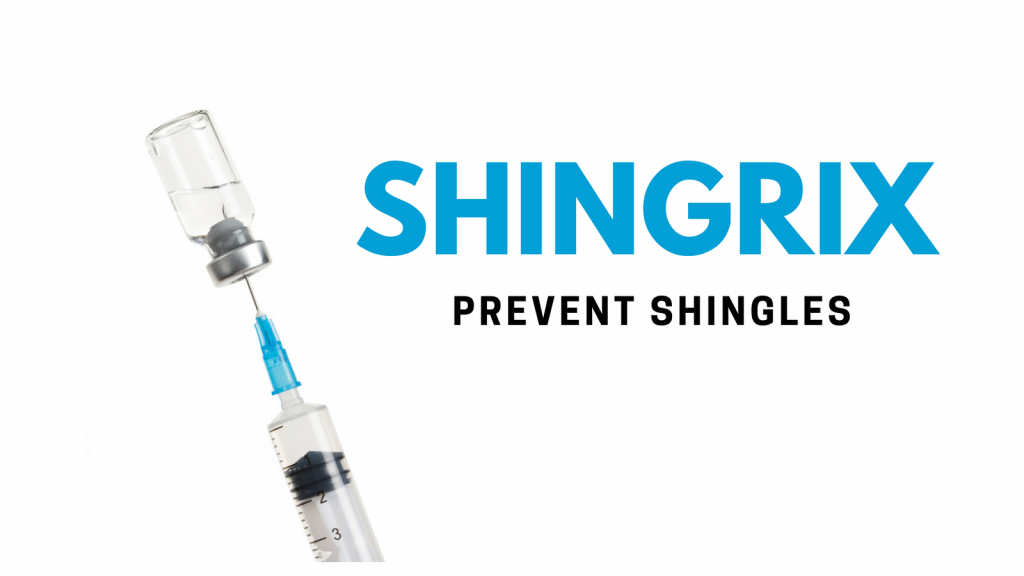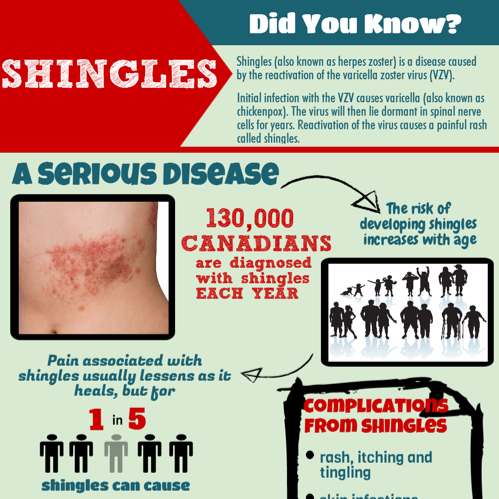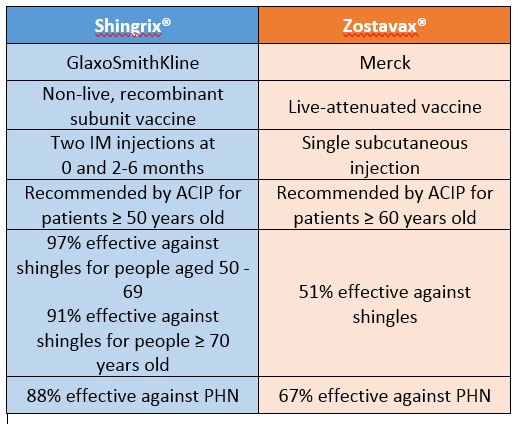Shingles vaccine info –updated on March 21, 2022
SHINGLES (SHINGRIX) VACCINE – HAVE IT DONE AT SINA PHARMACY
March is Shingles Awareness Month. To honor this we would like to promote getting vaccinated against this common and uncomfortable viral infection. Sina Pharmacy has started a new Shingles vaccine campaign. Our registered nurse (RN) or pharmacists can have a 15-minute appointment to go over your questions, check the criteria to see if you qualify for a publicly funded vaccine, and administer the shot. You can make your appointment by following the instructions below. After booking your appointment please make sure to fill the Consent Form and the COVID Questionnaire and submit it to us before your appointment. Please make sure to read the FAQ section below where the answer to most of your questions can be found.

There are two Shingles vaccines available in Canada: Shingrix ® and Zostavax ® II. Shingrix contains an inactivated form of the varicella-zoster virus and Zostavax contains a live, weakened form of the virus. Shingrix is 97% effective at preventing herpes zoster (shingles) in adults over 50 whereas the Zostavax shot is 50-64% effective in preventing shingles in those 50-70. Shingrix is the recommended vaccine for preventing Shingles as it has higher efficacy. Zostavax may be given to adults 50 and older who cannot receive Shingrix due to an allergic reaction.
INSTRUCTIONS :
Step 1: Check to see if you qualify for a public Shingles vaccine
Step 2: Book an appointment
Step 3: Download and fill out the consent form
Step 4: Email a copy of your completed form right after making your appointment.
Step 5: Read the instruction below about how to prepare and come in person for your appointment.
1. DO YOU QUALIFY FOR FREE SHINGLES VACCINE?
The Shingles vaccine is not free in B.C. As of February 1, 2021, Shingrix® vaccine coverage is only available at no cost to First Nations Elders who are 65 years old and older. The fee for each dose of Shingrix is $160 and you need to have two doses to develop full immunity.
NOTE: Most extended insurance companies cover the cost of Shingles vaccines. If you do not qualify for the public one, you can check with you extended insurance company for coverage terms.
2. BOOK YOUR APPOINTMENT
How to book your appointment: 1. select “Shingles Vaccine” from the Service tab below, 2. choose the appointment date and time, 3. provide your personal info, and 4. submit the data.
Reduce your health risks and have your Shingles vaccine done — All you need is your provincial health card & 15 minutes of your time.
4. Upload and return your Consent FOrm
Once you book your appointment, you should receive a confirmation email. You can return your completed consent form by replying to that email or send a copy directly to info@mysina.ca. Please make sure to write the subject line of your email as follows: “Shingles Vaccine Consent Form – YourLastName, YourFirstName”.
5. instructions about how to prepare and come in person for your appointment
- Have your BC Care Card or BC Services Card ready for patient identification
- Wear a mask or face covering to help protect yourself and our staff giving your injection
- Upon entering our facility, please sanitize your hands right away using the sanitizer by the entrance doors and follow the instruction on how to enter the room for receiving your vaccine.
- Please wear a short sleeve shirt to make it easy for our pharmacist to give you the shot in your arm.
- You will be asked to wait for around 15 minutes after the shot just in case you have a rare reaction to the shot.
- To avoid having too many patients waiting around in the pharmacy please stay sitted after your appointment and if you would like to browse around to pickup products please ask for staff help to minimize your time in the pharmacy and allow other patients to enter safely.
- Please come in on your own, without additional persons or children, unless you require the assistance of a caregiver.
- Please bring in as few belongings as possible as there will not be any space to put additional belongings.
Shingles occurs when the chickenpox virus (varicella zoster) goes from being dormant to active. No one knows exactly why that happens, although stress is suspected to be a factor.
More than 99% of adults worldwide who are age 50 and older have been exposed to the varicella zoster virus which means that they are carrying the dormant virus. According to the CDC, shingles strikes about 1 million people in the U.S. each year and nearly one in three adults will experience a bout of shingles in their lifetime.
Up to 10% of those who get shingles experience long-term pain after the rash has healed. This condition is caused by nerve damage sustained during a shingles episode and is called postherpetic neuralgia. There is no cure for postherpetic neuralgia, but topical (lotions) and/or systemic (pills) medications can help ease the pain. Here’s what you need to know about Shingles and Shingles Vaccines.
- Shingles, also known as herpes zoster, causes a painful rash and can lead to severe nerve pain which can last for months or years after the rash is gone. This is called postherpetic neuralgia (PHN). The rash develops into fluid filled blisters that break open and crust over. Shingles is contagious while in the blister phase. The rash usually affects only one side of the body but if near the eye it can lead to permanent eye damage.
Symptoms include itching, burning, numbness, tingling, aching, fever, headache chills, stomach upset. Symptoms can range from mild to severe.
Anyone can get Shingles but the likelihood and pain associated with the disease increases as you get older or if you are immunocompromised.
It is caused by the herpes zoster virus, which also causes Chickenpox. After an initial Chickenpox infection the virus remains dormant and is reactivated when the immune system is weakened.
- Shingrix® is the recommended vaccine for preventing Shingles.
- About 1 out of 3 people will get shingles in their lifetime.
- You cannot get shingles from someone who has shingles. However, it is possible for someone who has not had chickenpox or the chickenpox vaccine to get chickenpox from someone with shingles. This is uncommon and requires direct contact with the fluid from the shingles blisters.

There are 2 vaccines, Shingrix® and Zostavax® II, that protect against shingles. Shingles is caused by the varicella zoster virus, which also causes chickenpox. Zostavax® II contains a weakened form of the virus while Shingrix® contains only a part of the virus.

- Shingrix® is recommended for adults 50 years of age and older. This includes those who have had shingles disease or received Zostavax® II in the past and those who are not sure if they had chickenpox (varicella) infection in the past.
- You should wait at least 1 year before getting Shingrix® if you have had shingles disease or received Zostavax® II.
- You should not get the vaccine if you currently have shingles disease.
- You should not get the vaccine if you currently have shingles disease.
- Zostavax® II may be given to adults 50 years of age and older who cannot get Shingrix® due to a life-threatening reaction to a previous dose of Shingrix® vaccine or any part of the vaccine, or due to the Shingrix® vaccine being unavailable.
If you are getting Shingrix®, speak with your health care provider if you have had a life-threatening reaction to a previous dose of the vaccine or to any part of the vaccine.
If you are getting Zostavax® II, speak with a health care provider if you:
- Have had a life-threatening reaction to any part of the vaccine including gelatin or neomycin
- Have an immune system weakened by disease or medical treatment
- Have active, untreated tuberculosis
- Are pregnant or planning to become pregnant. Women should avoid becoming pregnant for 3 months after getting Zostavax® II
There is no need to delay getting immunized because of a cold or other mild illness. However, if you have concerns, speak with your health care provider.
- Shingrix is given as two doses, at least two to six months apart. The fee for each dose is $160.
- Zostavax® II is given as 1 dose and costs about $200.
The shingles vaccines are the best way to protect you from getting shingles. The vaccines have been shown to reduce the risk of getting shingles by 50% for Zostavax® II, and to more than 90% for Shingrix®.
For those who still get shingles after being immunized, the vaccines can reduce pain, including the type of pain that lasts after shingles.
The shingles vaccines are very safe.
Common side effects to the vaccines include headache as well as soreness, redness and swelling where the vaccine was given. Itching and a rash may also occur after getting Zostavax® II. Other reactions that may occur after getting Shingrix® include fever, muscle soreness, fatigue, shivering, nausea, vomiting and diarrhea.
It is important to stay in the clinic for 15 minutes after getting any vaccine because there is a very rare possibility, between one in 100,000 and one in a million, of a life-threatening allergic reaction called anaphylaxis. This may include hives, difficulty breathing, or swelling of the throat, tongue or lips. Should this reaction occur, your health care provider is prepared to treat it. Emergency treatment includes administration of epinephrine (adrenaline) and transfer by ambulance to the nearest emergency department. If symptoms develop after you leave the clinic, call 9-1-1 or the local emergency number.

